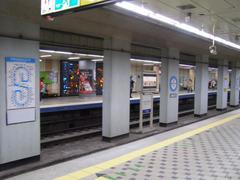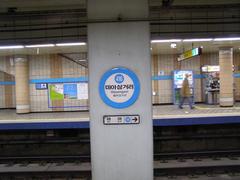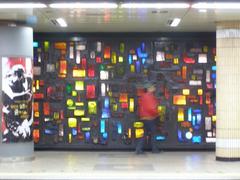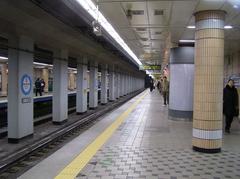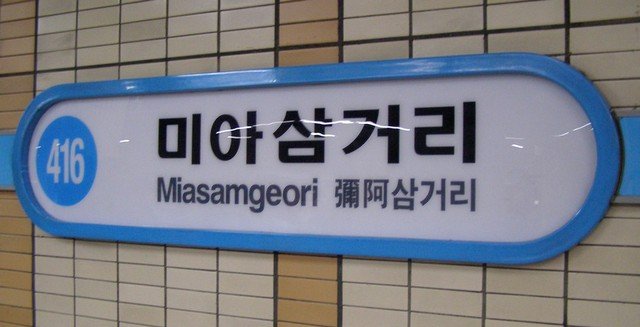
Miasageori Station Seoul: Visiting Hours, Tickets, and Comprehensive Tourist Guide
Date: 15/06/2025
Introduction
Miasageori Station (미아사거리역) is a prominent subway hub on Seoul Subway Line 4, located in the Mia-dong neighborhood of Seongbuk District in northern Seoul. Since its opening in April 1985, the station has played a vital role in connecting residential and commercial areas to central Seoul, supporting the city’s rapid urban development and its vision of a “10-minute city.” Today, Miasageori Station is much more than a transit point—it’s a gateway to vibrant markets, local eateries, parks, educational institutions, and cultural experiences.
This detailed guide provides all essential information for visitors, including station facilities, operating hours, ticketing options, accessibility features, nearby attractions, travel tips, and cultural etiquette. Whether you are a tourist, daily commuter, or cultural explorer, this resource will help you make the most of your visit to Miasageori Station and the surrounding Mia-dong area.
For official updates and further resources, consult the Seoul Metro official website and the Seoul Tourism Organization.
Table of Contents
- Introduction
- Visitor Information
- Getting to Miasageori Station
- Nearby Attractions
- Station Layout & Facilities
- Additional Facilities & Services
- Visiting Hours & Operating Times
- Travel Tips
- Historical & Urban Context
- Station’s Role in Seoul’s Transit Network
- Cultural Landscape & Local Attractions
- Accessibility & Inclusivity
- Events & Tours
- Photographic & Visual Highlights
- Subway Etiquette & Local Customs
- Frequently Asked Questions (FAQ)
- Conclusion & Call to Action
- References & Further Reading
Visitor Information
Operating Hours & Ticketing
- Operating Hours: Miasageori Station operates daily from approximately 5:30 AM to midnight, consistent with Seoul Metro’s standard schedule. For the latest updates, refer to the Seoul Metro official website.
- Tickets & Fares: Tickets can be purchased at automated machines in the station or by using the rechargeable T-Money card, which is recommended for convenient travel across subway, bus, and select taxis. T-Money cards are available at nearby convenience stores and provide discounted fares. Fare for a single journey on Line 4 starts at 1,350 KRW for trips within 10 km (Seoul Metro Ticketing Page).
Accessibility & Facilities
- Accessibility: The station is equipped with elevators, escalators, tactile paving, and wide ticket gates, ensuring barrier-free access for seniors, people with disabilities, and families with strollers.
- Multilingual Support: Signage is available in Korean, English, Chinese, and Japanese. Staffed information desks and digital kiosks offer support during peak hours.
- Connectivity: Free Wi-Fi and real-time train arrival displays are available throughout the station.
- Safety: Platform screen doors, CCTV surveillance, and uniformed security personnel are present to ensure passenger safety.
Getting to Miasageori Station
Miasageori Station is directly accessible via Seoul Subway Line 4 from major hubs like Seoul Station and Dongdaemun. Multiple bus routes and taxi stands serve the station, supporting seamless transfers. Visitors arriving from Incheon International Airport can transfer via AREX to Seoul Station, then to Line 4.
Nearby Attractions
Shopping & Markets
- Mia Traditional Market: Experience authentic Korean street food, fresh produce, and local crafts.
- Boutiques & Cafes: The area features a mix of modern boutiques and cozy cafes, perfect for shopping and relaxation.
Parks & Cultural Sites
- Mia Park: A nearby green space ideal for walks and outdoor relaxation.
- Local Cultural Centers & Museums: Host periodic exhibitions and community events that offer a glimpse into Korean traditions and contemporary culture.
Educational Institutions
- Korea University & Sungshin Women’s University: Nearby campuses occasionally host public cultural performances and events (Open Korea, 2024).
Station Layout & Facilities
General Structure
- Design: Underground station with two island platforms serving both directions of Line 4.
- Entrances & Exits: Multiple well-marked exits connect to different neighborhoods:
- Exit 1: Mia-dong residential areas
- Exit 2: Seoul Seongbuk Post Office, bus stops
- Exit 3: Beon-dong, local eateries
- Exit 4: Seokgwan-dong, retail shops
- Ramps or elevators are available at select exits for accessibility (Mapcarta).
Concourse & Ticketing
- Ticket Machines: Automated vending machines with multilingual options.
- Service Counters: Staffed during peak hours for assistance.
- Wide Gates: For wheelchairs, strollers, and luggage.
Platform Features
- Platform Screen Doors: For safety and climate control.
- Seating: Benches are spaced across platforms.
- Information Displays: Real-time train and service updates in multiple languages.
- Tactile Paving: For visually impaired travelers.
Additional Facilities & Services
- Restrooms: Clean, accessible facilities with baby changing stations.
- Lockers: Coin-operated lockers for secure luggage storage.
- Convenience Stores & Vending Machines: Access to snacks, drinks, hygiene products, and ATMs.
- Information Desk & Digital Kiosks: Route planning, local guides, and maps.
- Lost & Found: Managed by multilingual staff at the station office.
- Bus & Bicycle Connections: Bus stops at major exits and bike racks (including Seoul Bike “Ddareungi” stations) support multimodal travel.
- Art & Cultural Displays: Local art installations are periodically featured in the concourse (Wikimedia Commons).
- Cleanliness: Regular cleaning and recycling are prioritized for a hygienic environment.
Visiting Hours & Operating Times
- First train: Around 5:30 AM
- Last train: Around midnight
- Note: Schedules may vary by direction and day. Always check the latest times on the Seoul Metro website.
Travel Tips
- Best Time to Visit: Mid-morning to early afternoon for lower crowds.
- T-Money Card: Recommended for seamless travel across Seoul’s public transit.
- Mobile Apps: Use the Seoul Metro app or Audiala app for real-time updates.
- Exit 2: Easiest transfer to local bus routes.
- Free Wi-Fi: Available throughout the station for maps and navigation.
- Photography: Look for public art installations and mosaic artworks within the station.
Historical & Urban Context
Miasageori Station opened in April 1985 as part of Seoul’s expansion efforts to decentralize city functions and improve connectivity. Its name, meaning “Mia Intersection,” reflects its strategic crossroads location in Mia-dong. The station continues to play a central role in Seoul’s efficient “10-minute city” strategy, connecting northern neighborhoods to central hubs (World Bank, 2022).
Station’s Role in Seoul’s Transit Network
As a node on Line 4, Miasageori Station links residents to major destinations like Dongdaemun, Myeongdong, and Seoul Station. Integration with local buses, electric buses, and bicycle paths supports sustainable, multimodal transportation (Living Nomads, 2024).
Cultural Landscape & Local Attractions
The area surrounding Miasageori Station features a vibrant mix of traditional and modern Seoul. Seasonal festivals, public art, and local markets offer visitors opportunities to immerse themselves in Korean daily life (Open Korea, 2024). Nearby, the Seoul National University of Education’s Mia Campus and various cultural centers host events and exhibitions.
Accessibility & Inclusivity
Miasageori Station is designed for universal access, with elevators, tactile paving, wide gates, and multilingual signage. Public restrooms, clear wayfinding, and real-time information displays make navigation easy for all passengers (Living Nomads, 2024).
Events & Tours
While there are no official guided tours of the station, local cultural tours often include Mia-dong and its markets. Seasonal celebrations and community events are frequently held in the area. For current listings, check Seoul Tourism Organization.
Photographic & Visual Highlights
- Station Entrance: A landmark for photos—look for the distinctive signage.
- Mia Traditional Market: Bustling scenes ideal for capturing authentic Seoul.
- Public Art: Mosaic artworks and installations inside the station.
- Interactive Maps & Virtual Tours: Available on Seoul Metro’s website.
Subway Etiquette & Local Customs
- Priority Seating: Reserved for elderly, pregnant, and disabled passengers.
- Quiet Behavior: Keep conversations and phone calls low.
- Escalator Use: Stand right, walk left.
- Cleanliness: Eating/drinking is discouraged; dispose of trash properly (Seoulistic, 2024).
Frequently Asked Questions (FAQ)
Q: What are the station’s hours?
A: Approximately 5:30 AM to midnight daily.
Q: How do I buy tickets?
A: Use automated machines or a T-Money card, available at nearby convenience stores.
Q: Is Miasageori Station accessible?
A: Yes, with elevators, tactile paving, wide gates, and multilingual signage.
Q: What are nearby attractions?
A: Mia Traditional Market, Mia Park, local cultural centers, and universities.
Q: Are there buses and bikes available?
A: Yes, bus stops and public bike racks are located near major exits.
Q: Can I join a guided tour?
A: Cultural walking tours often include Mia-dong; check local tourism resources for details.
Conclusion & Call to Action
Miasageori Station is a model of Seoul’s commitment to efficient, accessible, and culturally rich urban transit. It is not only a gateway to the city’s northern districts but also a vibrant community hub surrounded by markets, parks, cultural sites, and educational institutions.
For the smoothest experience:
- Travel during off-peak hours.
- Use a T-Money card for convenience.
- Explore nearby attractions for an authentic taste of Seoul.
Stay updated through official resources like the Seoul Metro website and mobile apps. Embark on your journey to experience a unique convergence of Seoul’s past, present, and future at Miasageori Station.
References and Further Reading
- Visiting Miasageori Station: Hours, Tickets, and Nearby Attractions in Seoul, 2025, Seoul Metro (https://www.seoulmetro.co.kr)
- Miasageori Station Guide: Layout, Facilities, Visiting Hours & Travel Tips, 2025, Mapcarta (https://mapcarta.com/N357828647)
- Miasageori Station: Visiting Hours, Tickets, and Cultural Significance in Seoul, 2025, Open Korea (https://openkorea.org/history/the-evolution-of-seoul-ancient-to-modern-future/)
- Seoul Subway Guide, 2024, Living Nomads (https://livingnomads.com/2024/05/seoul-subway-guide/)
- Seoul Tourism Organization, 2025 (https://english.visitseoul.net)
- Seoulistic: How to Ride the Seoul Subway Like a Local, 2024 (https://seoulistic.com/korean-culture/how-to-ride-the-seoul-subway-like-a-local-etiquette-and-tips/)
- World Bank, 2022, Final LUTP Seoul Resilience Case Study (https://thedocs.worldbank.org/en/doc/3f6b01487645e32939f64d2bc2673ee4-0400012022/original/Final-LUTP-Seoul-Resilience-Case-Study-ENG.pdf)
- Seoul Metro Ticketing Page, 2025 (http://www.seoulmetro.co.kr/en/page.do?menuIdx=354)

